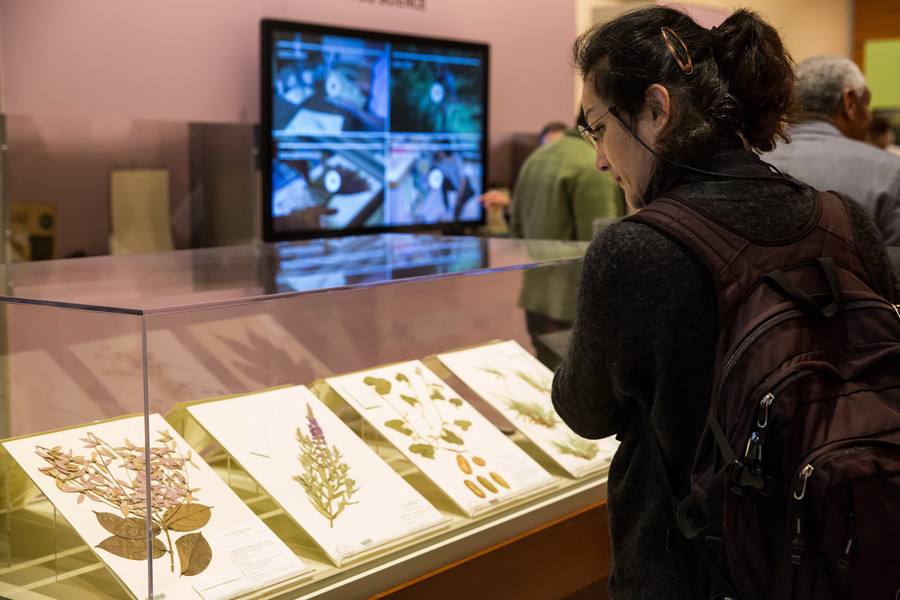What’s an herbarium, you ask?
In 1977, Scientific American published the story “Exploring the Herbarium” by Siri von Reis Altschul. The author was discussing the value of exploring herbaria for new plants for use as food, medicine and fiber, and she did work at the herbaria at Harvard and the New York Botanical Garden.
Despite an utter lack of interest in plants then, the idea of solving the world’s problems from materials already collected from all over the world was deeply exciting. Now the botanical garden is hosting an exhibition, “What in the World is a Herbarium?”
A visitor attending the opening lectures remarked, “I’ve always wondered what exactly is in a herbarium, so I was thrilled to come today.”
Since the exhibit will run until Oct. 29, there is still plenty of time to get an overview.
Opening day had the added attraction of actually being allowed to walk into the herbarium itself and see some of the short demonstrations on specimen sheet preparation and digitization for public internet access.
For those who would like to see the herbarium for themselves, the botanical garden will open it again on Earth Day, April 22, with guided tours at noon and 3 p.m. on a first-come basis. And once the Chihuly exhibit opens April 22, a well-planned visit should begin in the conservatory, continue to the art gallery of the LuEsther T. Mertz Library, and end in the fourth floor rotunda.
From there, the visitor is perfectly positioned to descend to Ross Hall on the first floor and take in the herbarium exhibit as well.
So what, then, is a herbarium? Think of a library, but instead of books catalogued by author or subject, imagine shelves and shelves of individual plant specimens divided into plant families — presently numbering 620 — in temperature-controlled surroundings. The storage cabinets are kept at 70 degrees, with relative humidity at 45 percent.
The botanical garden is the second-largest herbarium in the world with 7.8 million, the largest being Museum National d’Histoire in Paris. There are 30,000 newly collected specimens added each year, plus additional materials from other large institutions that have been forced to close their herbaria.
The Brooklyn Botanic Garden’s herbarium is now on loan to the New York Botanical Garden. Other acquired collections include the algae specimens from The Field Museum in Chicago, the Truman G. Yunker Collection of DePauw University, the herbarium from Wabash University of Indiana, as well as personal collections like William Mitten’s mosses.
The first European sheets of collected and dried specimens date from the 1500s. Quickly, the concept and the relatively simple techniques spread among botanists so that within 30 years it became commonplace for botanists to make and maintain their own private collections.
The first herbarium, as well as the first botanical garden, was created by Luca Ghini, a professor of medicine and botany at the University of Pisa, around 1544. Because special archival paper was not yet a concept, collectors used what they had.
When these non-archival papers began to break down, and it wasn’t possible to remove the specimen from the sheet, a new sheet of archival quality is glued underneath.
One of the oldest specimens currently in the collection is a 1688 fern leaf — Saccoloma domingense — collected in Jamaica. As materials are reviewed, it is not surprising that new “oldest” specimens are regularly discovered.
Care must be taken to dry plants quickly in the field in order to maintain their structure and hold their color. Possible insect infestation is prevented nowadays by being frozen at negative-40 degrees Celsius for three days after receipt at the botanical garden. In the past, methylbromide — a dangerous compound — was used. Every time a specimen is lent out and returned, it goes through the freezing process again.
The botanical garden herbarium was founded in 1891 under the directorship of Nathaniel Lord Britton, and its collection focused primarily on plants of the Americas. In 2002, the herbarium was rededicated — as part of the International Plant Science Center along with the LuEsther T. Mertz Library and Ross Lecture Hall — as the William and Lynda Steere Herbarium.
With a background as a board chair at Pfizer, and a father who was a noted bryologist and director and president of the botanical garden, the Steeres were among the visionaries behind the botanical garden renaissance that began in the early 1990s.
Many famous names have contributed herbarium materials. They include Charles Darwin, Capt. J. Cook, George Washington Carver (despite his fame for developing myriad uses for the peanut), John Muir and John J. Audubon.
So far, I haven’t discussed what the uses of a herbarium are. I think we will consider this a cliffhanger.






